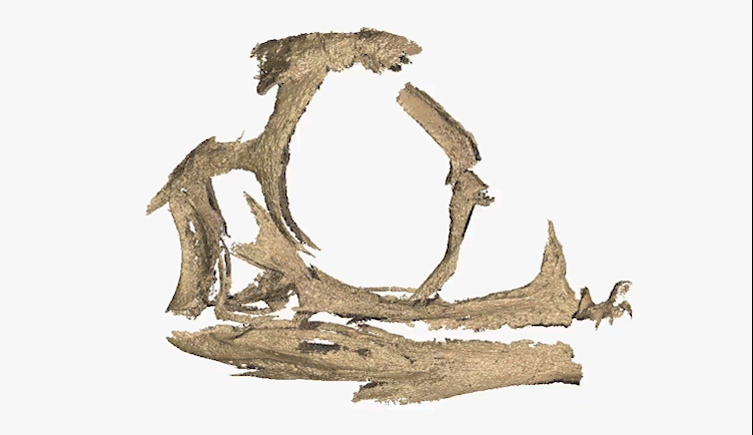Digital Reconstructions Reveal 200-Million-Year-Old Dinosaur Embryo’s Unusual Teeth
New scans suggest unhatched dinosaurs reabsorbed a set of teeth during development
/https://tf-cmsv2-smithsonianmag-media.s3.amazonaws.com/filer/53/2a/532afeab-a79d-429e-9ae1-84e9c453191d/228683.jpg)
Some 200 million years ago, a long-necked, plant-munching dinosaur called Massospondylus carinatus laid a clutch of eggs. Sadly, the doomed creatures within never got the chance to hatch. But thanks to a new digital reconstruction technique, the world can now better acquaint itself with the petite, pointed skulls of Massospondylus’ ill-fated offspring—eons after their species went extinct.
Described last week in the journal Scientific Reports, the skulls of the Massospondylus embryos measure just an inch or so in length. They also sport extra teeth that would likely have been reabsorbed or shed before the young hatched—a phenomenon that’s been described in today’s reptiles, reports Nicola Davis for the Guardian.
The findings feature some of the oldest dinosaur eggs ever discovered, and reveal striking parallels between the developmental trajectories of these ancient creatures and those of some of their distantly related modern relatives.
“It’s incredible that in more than 250 million years of reptile evolution, the way the skull develops in the egg remains more or less the same,” study author Jonah Choiniere of the University of Witwatersrand says in a statement. “Goes to show—you don’t mess with a good thing!”
The seven eggs in the study—three of which contain embryos—were first uncovered nearly five decades ago in South Africa’s Golden Gate Highlands National Park. Had they hatched as planned, the pint-sized creatures within would have ballooned to long-necked adults roughly 15 feet in length that carried their 2,000-pound bodies on two well-muscled legs.
Wary of the eggs’ fragility and rarity and lacking the tools to analyze their contents, researchers spent years performing mostly superficial experiments on the embryos. Then, in 2015, Choiniere, along with fellow University of Witwatersrand researchers Kimberley Chapelle and Vincent Fernandez, got the chance to scan the specimens at France’s European Synchrotron. At the facility, the team used high-powered x-rays to visualize the fossils’ contents without destroying them, generating a series of images detailed enough to capture individual bone cells. The researchers then pieced the images together in three dimensions, revealing aspects of the embryos’ anatomy that had previously been hidden from view.

Other researchers had previously thought the trio of embryos had been on the verge of hatching. But when the University of Witwatersrand team compared their new scans to data from the embryos of distant modern relatives of dinosaurs, including crocodiles, chickens, turtles and lizardsat different stages of development, they found that the growing Massospondylus may have been no more than 60 percent of the way through their incubation, Vincent says in a separate statement. (Researchers still aren’t sure how long total incubation lasted.)
To the Guardian, University of Bristol paleontologist Michael Benton, who wasn’t involved in the study, praised the research as a “fantastic” use of modern technology. “This gives a reliable method of aging an embryo of a dinosaur for the first time,” he says.
The comparisons also revealed that, despite being separated by hundreds of millions of years of evolution, today’s bird and reptile embryos seem to form bone tissue in steps similar to those that dictated dinosaur development during the Triassic, which lasted from about 199 million years ago to 251 million years ago.
In line with this, the skulls of the Massospondylus embryos seemed to be studded with two types of teeth: the serrated precursors to what they’d use to chomp plants as adults, and a set of simple cones that the researchers think would have disappeared before the creatures hatched. So-called “null generation” teeth are seen in crocodiles, geckos and other reptiles that romp the earth today. By the time one of these animals hatches, it has sometimes already “replaced its teeth maybe twice,” Vincent says in the second statement.
Though the preservation of this trait throughout evolution makes sense, these embryos mark researchers’ first evidence of this developmental juncture in dinosaur eggs, Chapelle tells the Guardian, making the discovery a unique freeze frame of a time long gone. “We have never seen that before,” she says.
/https://tf-cmsv2-smithsonianmag-media.s3.amazonaws.com/accounts/headshot/10172852_10152012979290896_320129237_n.jpg)
/https://tf-cmsv2-smithsonianmag-media.s3.amazonaws.com/accounts/headshot/10172852_10152012979290896_320129237_n.jpg)